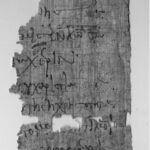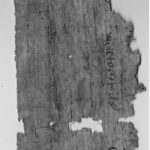| Artefact ID | 162 |
| TM ID | TM 129873 |
| Findspot (DEChriM ID) | 58 (Dayr al-ʿIẓām) | Class | Textual |
| Material | Papyrus |
| Writing medium | Sheet/roll |
| Text content | Documentary |
| Language | Greek |
| Archive/Dossier | Archive |
| Description | Gonis 2008: 77-80, no. 2; P.Misc. inv. II 98a + I 134a: Fragmentary letter to Apa John. The letter refers to a praeses who may be due to meet with Apa John; the latter was apparently asked to raise an issue with the governor involving his correspondent, perhaps regarding a petition. The sender requests to be remembered in Apa John's holy prayers. Recto: the text is written along the fibres. Verso: docket, along the fibres. The Apa John of this archive was identified with the famous John of Lykopolis known by literary sources by Zuckerman 1995. Most of the Greek and Coptic letters of this archive are addressed by monks, clerics, soldiers, state officials and individuals to Apa John, so that he would intercede in their favour in dealings with the authorities or pray for them. The editor notes here (l. 1-2n) the early papyrological attestation of the epithet theophilestatos used for an ecclesiastic (l. 2: "to the most God-loving Apa Ioannes"), which becomes common from the 5th c. |
| Selection criteria | Mention of Christian individuals/communities, Christian terms/formulas/concepts, Nomina sacra |
| Date from | 375 |
| Date to | 399 |
| Dating criteria | Palaeography and archive connection (Gonis 2008: 69-72) |
| Absolute/relative date | Relative date |
| Archaeological context | According to Constantine Zuckerman's reconstruction, the Apa John’s letters were presumably found in September 1897, during the excavations of Farag Ismael and Yassa Tadros on the mountain of Siout (Lykopolis), in the ruins of Dayr al-'Azam, the site of the monastery of John of Lycopolis. Yet they never reached the museum in Gizeh – like the other objects unearthed during these excavations – and must have ended on the market, where they were bought soon after the excavations (Zuckerman 1995: 191-192; Van Minnen 1994: 80-82, Gonis 2008: 69-72). Although not proven, this attractive hypothesis is generally accepted by scholars (see discussion in Van der Vliet 2015: 166-167, and some reservations in Choat 2017: 37-40). |
| Accession number | Oxford, Sackler Library, Papyrology Rooms EES P. Misc. inv. I 134 a + EES P. Misc. inv. II 98 a |


 Json data
Json data





